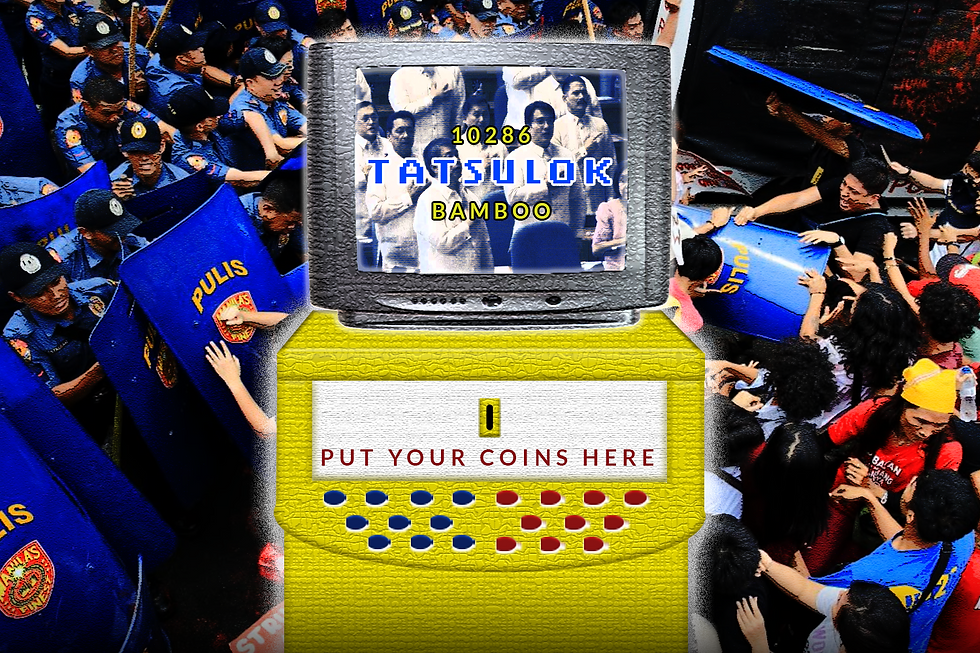When a Nation Sings, Power Trembles
- The Communicator
- Sep 27, 2025
- 4 min read
Under the heavy weight of a relentless September sky, as a typhoon’s winds swirled the distance but spared the gathering, the voices of the crowd rose in harmony, carrying the weight of the Philippine national anthem’s closing line: “Ang mamatay nang dahil sa 'yo.” The line took on a new life—a call not just to remember, but to resist and refuse silence.

At Luneta Park, thousands gathered to mark the 53rd year since the declaration of Martial Law. In the sea of people, art once again rose as resistance. Bold, hand-painted banners and striking slogans like “Walang mali sa paglaban, may mali kaya lumalaban.” waved proudly in the air, while street art on nearby walls depicted images of oppression. Colorful flags, each carrying a message, also fluttered. The air was thick with the sound of protest songs, their lyrics rising above the crowd. It carries memory. It carries grief. It carries resistance.
Because instead of retelling Martial Law’s historical facts that remain etched in our history yet constantly challenged by distortion, resistance today continues to be told through music, art, and literature. These are the new forms of defiance, echoing the voices that refused to be silenced back then and amplifying those that continue to rise today. Songs that once gave voice to the censored, and songs that reclaim that same spirit in new forms today. Music, art, and literature as lifelines across generations.
The Anthem That Would Not Die
During the Marcos dictatorship, when newspapers were muzzled and protest leaders jailed, music moved through crowds like contraband. There was a time when singing “Bayan Ko” could land you in jail. The regime feared the ballad’s power to unite, to ignite. It was banned from airwaves, forbidden in rallies, and censored in public squares. Yet the song lived on—in hushed voices at kitchens, in whispered humming inside jeepneys, and in the quiet courage of those who refused to let melody die.
And when the moment came, people sang it loudly. At protests, at funerals, at marches. The once forbidden tune rose like thunder, with its aching words “Pilipinas kong minumutya, pugad ng luha at dalita, aking adhika, makita kang sakdal laya.” It was no longer just a song. It was an act of rebellion, a declaration that truth cannot be outlawed.
Other works like “Pagbabalikwas,” “Bagong Pagsilang,” and “Ang Masa” emerged as cultural weapons, often performed in rallies where the stakes of singing were as high as survival itself. Literature and theater joined the chorus—works like Dekada ‘70 by Lualhati Bautista became both novel and a film, its story of one family under Martial Law still resonates decades later. Zild’s reinterpretation of Dekada ‘70 in music bridges the gap: from page to stage, from past to present.
These cultural pieces were more than art; they were strategies of survival. They preserved memory when official history tried to bury it.
To sing was to resist. To write was to endure. To paint was to remember.
The Fire Rekindled
The fall of the dictatorship did not end the soundtrack. Some songs only grew louder. Today, the same fire burns in new voices. At Luneta Park, Kapangyarihan by Ben&Ben, a song that echoes across social media and protests alike with its sharp line, “Akala niyo ba, ang kapangyarihan ay nasa inyo? Sino ba kayo?” challenged those who wield authority, reminding the crowd that power belongs to the people.
Gloc-9’s “Upuan” resurfaced as a rallying cry. Protesters sang its biting lyric—“Kayo po na nakaupo, subukan niyo namang tumayo”—directed squarely at leaders seated in comfort while citizens endured hardship. Online and offline, the song has become a mirror and a dare. In addition, Bamboo’s “Tatsulok” still rings true, declaring that “Habang may tatsulok at sila ang nasa tuktok, ‘di matatapos itong gulo.” It remains both a warning and a call to dismantle structures of inequality.
Meanwhile, IV of Spades’ “Bata, Dahan-Dahan!” speaks softly to a restless generation, while Dilaw’s “3019” and “Kaloy” add searing critiques of corruption and social neglect. Even Bamboo’s “Noypi,” once a pop anthem, has been co-opted in rallies, its “Hoy, Pinoy ako!” turned into a defiant war cry. They carry forward this tradition: assessing power, insisting on justice, and questioning silence.
Why We Still Raise Our Voices
Across decades, one truth holds steady: art refuses to be silenced. Instead of fading into archives, they leap across generations. Whether in the form of protest literature, street murals, or songs sung at rallies, cultural expression sustains memory and strengthens resolve. Art is memory. Music is accountability. Literature is testimony. They knit together past and present, grief and hope. It transforms grief into solidarity, fear into courage, silence into sound.
In every lyric carried by the wind, in every placard painted by hand, in every voice raised against power, one message resounds: We will not forget. We will not bow. We will not stay silent. To remember, to resist, to refuse silence—this has always been the chorus. And as long as there are voices willing to sing, it will never be silenced.
Because when a nation sings, power trembles.
Article: Xyra Caryl Zaleta
Graphics: Ericka Castillo








Maximize your betting success with Khelraja’s free cricket betting tips. Our expert insights guide you to make smart decisions during every match. From analyzing team form to predicting outcomes, Khelraja equips you with the knowledge to bet confidently and responsibly while enjoying every thrilling moment of live cricket action.